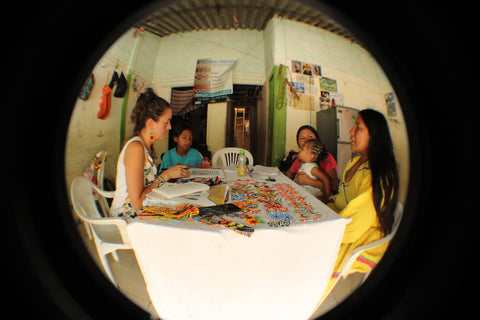
The Embera Chamí are one of the indigenous tribes of Colombia. In Colombia the Embera culture consists of 3 different groups: Chamí, Katío and Siapidara.
The differences between the Embera groups respond more to the areas where they reside. The meaning of Embera Chami is -People from the mountain. During the pre-columbian era the Embera were known as Indians "Choco" or “Chocoes". “They were, in their origins Nomadic group dedicated to hunting, Fishing and harvesting ".
Before the colonization of their territories, this tribe presented within its social dynamics, a strong relationship with the earth. The land was the basis of existence of the community. There was no conception of property or value of land and the different groups claimed the usufruct of the natural resources for the survival of the whole communities. The collective character of the land united the value of belonging to a community with the work it takes to support it.
The Embera Chamí People's close relationship with the land began to disintegrate with the beginning (of the process) of the Spanish conquest, which led to the forced abandonment of the lands with which they had created that relationship, relocating them to rainy jungle territories with a completely different climate, soil, and productivity from what they had always known.

Today, the Embera Chamí people continue to suffer from these changes with the overwhelming process of colonization. The presence of armed groups has led to more forced displacement, for reasons such as homicide, massacres, threats and armed confrontations. This tribe is at risk of physical and cultural extinction. The Embera Chami Tribe today represents 2.1% of the indigenous population of Colombia.
The Embera retain much of their own thought, oral tradition, craft tradition and ritual celebration. The figure of Jaibaná stands out in their culture, and he serves as a traditional doctor who also exercises authority, social control and territorial management. In his ceremonies he uses drinks like pilde or borrachero to communicate with the spirits.

Two And a half years ago we started working with 3 families of Embera Chami artisans (14 people) displaced due to violence, that currently live in a vulnerable neighborhood called “The Breezes”.

One of The Embera Chami crafts is weaving with beads. They describe their work more as an ancestral thought than as an art. Mothers have taught daughters, generation after generation, the techniques, the meaning of each color, the signs and the drawings, creating the cultural legacy through the art of weaving. The most appreciated piece is the Okama, a necklace with a high symbolic content and of exclusive feminine use.

Okama (“path that runs the neck") is a necklace that gives distinction to the woman who carries it, telling her history and role in the community. The girls receive their first Okama with their first period.
They also weave bracelets, earrings and other necklaces loaded with ancestral symbolism, and use them as amulets for protection, love, new projects, and joy, among others.






free download netscape browser for windows xp freebarbie rapunzel game free download pck7 total security antivirus download for pc windows 10canon capture perfect 3.0 download windows 7 freepc whatsapp apk download windows 10download elder scrolls skyrim for pc freedownload magic mouse 2 utility for windows 10format factory free download latest version for windows xp cnet freehasp driver for inpage windows 10 free downloadmicrosoft office powerpoint presentation 2007 free download for windows 7 free
[url=https://fundamentservis.ru/gigabyte-ga-z170x-gaming-gt-ga-z170x-gaming-gt-rev-2/]skype windows live messenger download free
[/url]
[url=https://fundamentservis.ru/fifa-15-fastest-players-fifa-15-player-ratings-top/]interior design software free download full version for windows 10
[/url]
[url=https://fundamentservis.ru/microsoft-common-controller-for-windows-class-3/]blue stack app free download for pc
[/url]
[url=https://fundamentservis.ru/microsoft-project-2003-free-download-download/]download vim editor for windows free
[/url]
[url=https://fundamentservis.ru/tp-link-tl-wn823n-windows-10-tl-wn823n-v2-driver/]download my craft game free for pc
[/url]
[url=https://fundamentservis.ru/why-is-windows-so-expensive-why-are-windows-so/]ben 10 2017 pc game free download
[/url]
[url=https://fundamentservis.ru/corsair-scimitar-not-detected-corsair-scimitar-rgb/]javac compiler download windows 10
[/url]
[url=https://fundamentservis.ru/integra-dtr-70-4-integra-dtr-70-4-thx-ultra2-plus/]download adk for windows 10
[/url]
[url=https://fundamentservis.ru/amd-radeon-hd-8350g-amd-radeon-hd-8350g/]angry birds rio free download pc full version windows 7
[/url]
[url=https://fundamentservis.ru/mount-and-blade-warband-trainer-skill-question/]apex legends download pc free
[/url]
adobe premiere pro download free full version windows 10
windows lock software free download free
facebook messenger for windows xp free download free
avengers theme download for windows 10
download tango for pc windows 10
https://fundamentservis.ru/corsair-void-pro-usb-not-working-what-if-a-void/
https://fundamentservis.ru/frozen-sisters-in-cinema-game-info-frozen-sisters/
https://fundamentservis.ru/hp-1012-driver-windows-7-hp-customer-support/
https://fundamentservis.ru/tv-show-folder-icons-tv-show-folder/
https://fundamentservis.ru/last-dream-strategy-guide-the-last-dream/
python 3.6 download windows 10 free
download themes for windows 10 pc
jgrasp download free windows free
icon pack windows 10 free download
duo download for windows 10
internet security free download for windows xp free
download ftp server windows 10
download free pc roms
html compiler download for windows 10
god hand game download for pc windows 7
intel dual band wireless ac 7265 driver download windows 10
don t starve hamlet download free pc
canon eos utility free download for windows 10
dell bluetooth driver download windows 10
brian lara cricket 2007 pc game free download utorrent
https://fundamentservis.ru/dell-latitude-e6530-bluetooth-drivers-for/
game free download for pc windows 10 [/url] 2 pc full game download [/url] free camera for windows 10 [/url] audio device for windows xp sp3 free [/url] 2 pc game free download [/url] keygen windows 7 download free [/url] photoshop 7.0 free download full version for windows 8 free [/url] antivirus free download windows 7 64 bit free [/url] adobe flash player download for windows 10 [/url] citrix receiver for windows 8.1 64 bit free [/url]https://fundamentservis.ru/patch-6-2-notes-wow-6-2-ptr-patch-notes/
https://fundamentservis.ru/canon-pro-100-firmware-pixma-pro-100/
https://fundamentservis.ru/xps-13-9350-drivers-xps-13-9350/
https://fundamentservis.ru/remove-koobface-from-mac-how-to-remove-koobface/